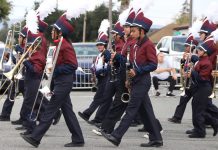After taking summer school, most Hollister School District
students who were at risk of being held back saw improvement,
district officials reported this week.
After taking summer school, most Hollister School District students who were at risk of being held back saw improvement, district officials reported this week.
In the summer of 2007, 760 students took intervention courses in the district. These first- through seventh-graders were considered behind their grade levels in either math or science, and many were close to being retained.
District officials are considering the intervention courses successful overall, with nearly all grades’ test scores improving significantly in both math and language arts
The Hollister School District offers summer school for special education students, for English language learners and for Migrant Education program students in addition to the intervention courses. Overall, 2,830 students took summer school – a little less than half the district’s total student population.
Anita Franchi, assistant superintendent of educational services, said the summer school program could be considered successful – especially the math portion.
“There could have been a lot more (students) retained had there not been interventions provided. That showed that there was progress,” Franchi said.
There were 108 students in the Hollister School District who were held back this year.
Franchi said that some students who took summer school classes were still retained, but most made strides.
“The goal is to help them all pass,” Franchi said. “But on the other hand, if the student really isn’t ready, they shouldn’t go on.”
The students were designated as needing the intervention summer school courses based on failing grades and test scores.
Most of the students who took math or language arts intervention courses took a test before and after taking the summer school courses. Overall, all grades saw improvement in both math and language arts – except second- and third-grade language arts students.
In math, students improved significantly after taking summer school courses. Third-graders, for instance, improved 32 percent over the course of the class.
Franchi said district officials are beginning to look at new programs for language arts so that more improvement is seen in those students as well.
“What you need to do is give them something that is designed more as an intervention,” Franchi said. “You need to give them the skills that students lack the most.”
The regular summer school program – not including the migrant education, paid for through federal funding – cost the district $365,846 in expenditures, according to Chief Business Official Jack Bachofer. The state reimburses the district $4.08 per student hour.
Because they have not yet calculated all the revenue from the students, the district does not know exactly how much the summer school program cost.
“We try to keep the cost low, but we don’t always achieve that because we’re not trying to make money – we’re trying to break even,” Franchi said.









